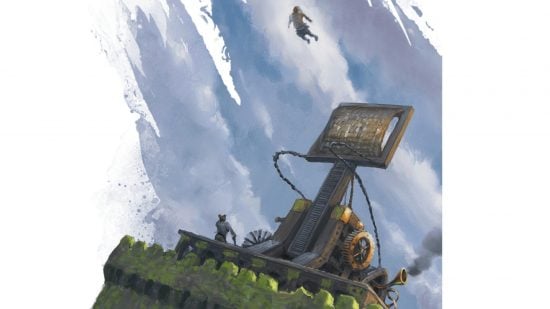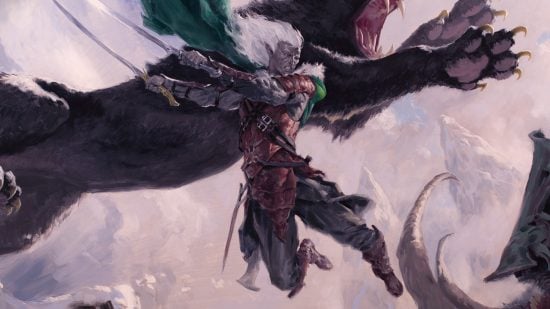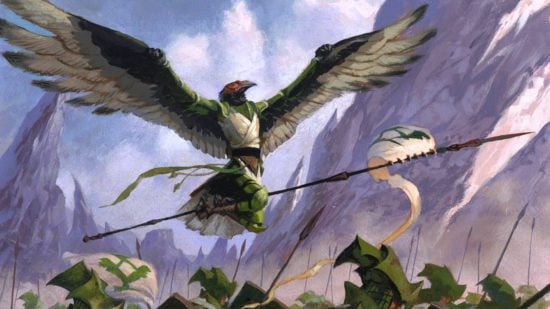Fall damage 5e is one of those rules that’s easy to misplace in the middle of a Dungeons and Dragons game. A beloved party member is split seconds away from plummeting to their doom, but no one can remember the life-or-death damage calculation – what’s a DM to do? We’ll save you some time and tell you exactly how DnD fall damage works.
Whatever DnD classes or DnD races you’ve got on your DnD character sheet, every player-character is capable of taking a tumble. We can’t stop you from hitting the ground (you’ll need the right 5e spells for that), but we can tell you, in rules terms, exactly how much it’s going to hurt.
Basic rules for fall damage 5e
According to the Player’s Handbook, falling is a pretty simple affair. After falling, a creature takes 1d6 bludgeoning damage for every ten feet it fell. The creature becomes prone when they land unless they can avoid taking the fall damage altogether.
The maximum damage a creature can take from a fall is 20d6. Depending on what DnD campaigns you’re playing, this can be pretty generous. For example, if you fall from the Overlook of Castle Ravenloft in Curse of Strahd, you’ll plummet more than 1,000 feet. 20d6 sounds a lot better than 100.
Advanced rules for fall damage 5e
The DnD book Xanathar’s Guide to Everything expanded on the rules for falling in 5e. This means we now have rules for the rate of falling, as well as how flying creatures are affected by a fall.
Rate of falling
If you fall from a particularly great height (the back of a flying DnD dragon, perhaps), you may be falling for more than one turn. Wizards of the Coast has ruled you can only fall 500 feet in a single turn, and it’ll take another turn to descend any further. Returning to our example from before, you would hit the ground two turns after falling from the Overlook of Castle Ravenloft.
The maximum damage still applies if you’re falling from a great height. The bright side of this new rule is it buys you time to save yourself from becoming a great big splat on the ground.
Flying creatures and falling
There are a few ways a flying creature could end up falling:
- They’re knocked prone 5e
- Their speed is reduced to zero feet
- They cannot move, e.g. by becoming paralyzed
This doesn’t apply if a creature can hover or it’s using a spell to fly. The rules are more designed for flying races like the DnD Owlin or the Aarakocra.
Xanathar’s suggests an optional rule for flying creatures which makes it easier for them to survive a fall. Using this, you’d subtract a creature’s current flying speed from the distance it fell, and then calculate the damage of the remaining falling distance. According to the sourcebook, this could represent a prone creature flapping their wings to slow the fall.
Flying creatures still only fall 500 feet per turn. This means, if a prone flier starts its turn falling, it can spend half its flying speed to end the fall.
Damage from a falling object
There are a lot of gaps in the rules for DnD fall damage. One of those is the damage dealt by another object falling onto you. You can use a DnD homebrew to calculate damage from a falling object any way you like, but if you’re stuck for ideas, here’s a suggestion – try things the Pathfinder way.
There are a lot of differences between Pathfinder and DnD, but there are enough similarities that Pathfinder’s fall damage rules could be ported over to 5e.
In Pathfinder 2e, a creature has a chance to dodge a falling object, with the damage calculated depending on the degree of success the player rolls. In D&D, this could mean a character makes a Dexterity saving throw to avoid being hit. On a success, they avoid taking damage; on a failure, the damage taken is calculated the same as if they had been the one falling.
Pathfinder also says it’s basically impossible to be hit by an object falling from a great height. We think this also makes sense for D&D – if an object spends more than one turn falling, it’s entirely plausible that your character could get out of the way.
Falling on different surfaces
Landing in a pool of water is going to feel very different from landing on the cold stone of a castle courtyard. However, D&D doesn’t have any rules to differentiate between different surfaces. You know who does? That’s right – Pathfinder again.
In Pathfinder, a fall that lands in a soft substance like water or snow takes up to 20 feet off the fall before calculating damage. If you jumped in intentionally (maybe to show off your swan diving skills), you can even subtract 30 feet of distance. If you think your D&D party deserves a gentler landing, this might be an effective way to homebrew that into your game.
Looking to enhance your Dungeons and Dragons experience? We can recommend everything from DnD maps to DnD miniatures. We’re also constantly updating our guide to the DnD 2023 release schedule so you can keep up with the latest sourcebooks.





